The Japanese kappa is one of the most famous traditional yokai in modern day Japan. Even if you think you've never heard of it, you've probably encountered a reference at your local sushi bar. Ever wonder why cucumber roll is kappa maki when the word for cucumber is きゅうり? Come with us on a journey through the legend of the kappa. You may never look at that particular menu item the same way again.
And if you want a quick summary before diving in deep (literally, into the river) check out our video that encapsulates kappa lore in under seven minutes:
Done with the crash course?
Good. Because it's time to get extra friendly with this slimy, aquatic weirdo. Hold onto your butts.
Know Your Kappa
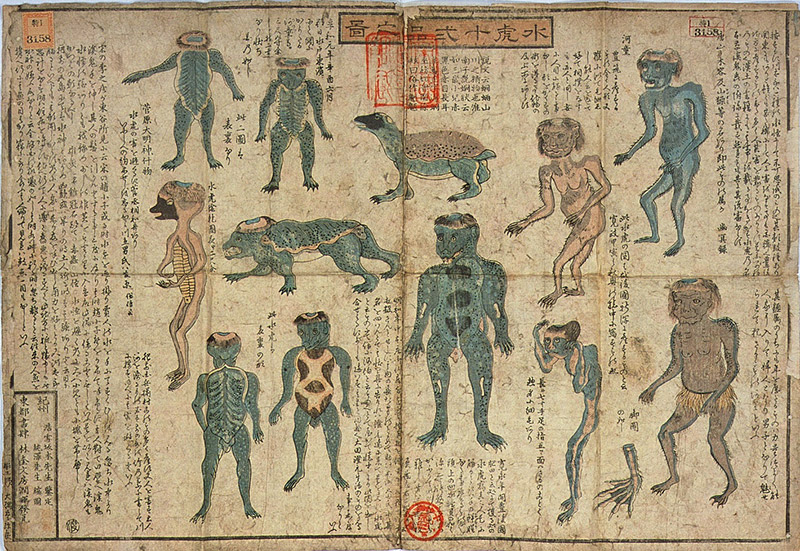
As with many creatures both mythical and real, the kappa doesn't always look exactly the same. But if you encounter a vaguely reptilian creature walking upright or hanging around in a body of water, you may be dealing with a kappa. They're the size of a small child or large monkey, with humanoid arms and legs. Otherwise they have mostly reptile or amphibian-like qualities. They have webbed digits for swimming and may be scaly or slimy. They're reminiscent of a giant frog or turtle. Usually they have something like a turtle shell on their back and a beaky sort of snout. Japanese Kappa are said to smell fishy, and they're often a bluish or greenish color.
What will always be distinctive despite these variations is the top of their head. You may momentarily wonder why this creature has the haircut of a European monk, with a frill around its bald spot. Look closer and you'll see that the "bald spot" is actually a small dish of water. Keep an eye on this, because it will be critical to your upcoming lesson on Defense Against Kappa.
The other most consistent feature of the kappa is its favorite food. They have a fondness for eggplant and for several plants of the cucurbit family: melons, squash, and most especially cucumber. So that cucumber sushi roll isn't named for its ingredients, but for its most famous devotee.
Where the Kappa Came From
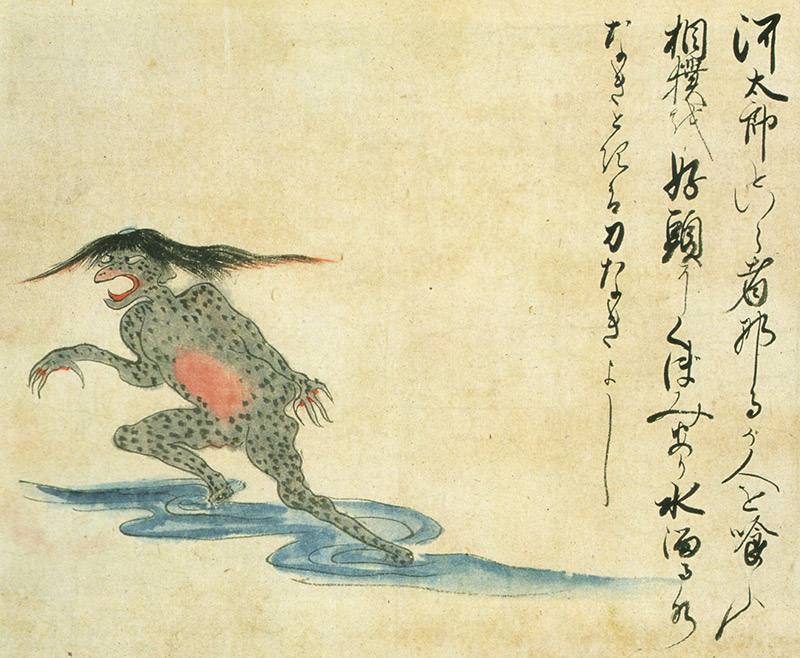
The name "kappa" means "river child," and it's often called a "water sprite" in English explanations. Both of these give a much cuter impression than is good for your safety. The regional variations went by many different names, including gawappa, kawatarō, suiko, kawappa, kawako, kawaso… There seems to have been a basic east-west difference at one time. The turtle-shell-bearing kappa came from the east and the kawatarō in the west, which is more hairy and monkeylike. By the nineteenth century the reptilian eastern kappa seems to have edged out his western counterpart. Modern depictions of kappa are usually along those lines. We can be glad for this, because somehow the hair on top of everything else is just too creepy.
Some of the other names for the Japanese kappa suggest the animals it might have been partly based on: monkeys, turtles, and the now-extinct Japanese river otter. The river otter was about two feet long and nocturnal, so a glimpse of it standing on its hind legs in the middle of the night, combined in your mind with the features of other creatures that you know frequent the dark watery depths, could indeed make a fearsome monster. The otter certainly seems like a plausible origin for the hairy-but-aquatic kawatarō.
Another suggestion is that the kappa is based on the Japanese giant salamander. As far as I can tell that theory only goes back as far as a 2012 TV show. But having personally seen how aggressively this otherwise slow-moving, globby aquatic creature goes after its food, I find it pretty plausible.
Or maybe the simpler theory is that what people were seeing…. was actually a kappa. You'll have to decide that one for yourself.
Danger: Kappa
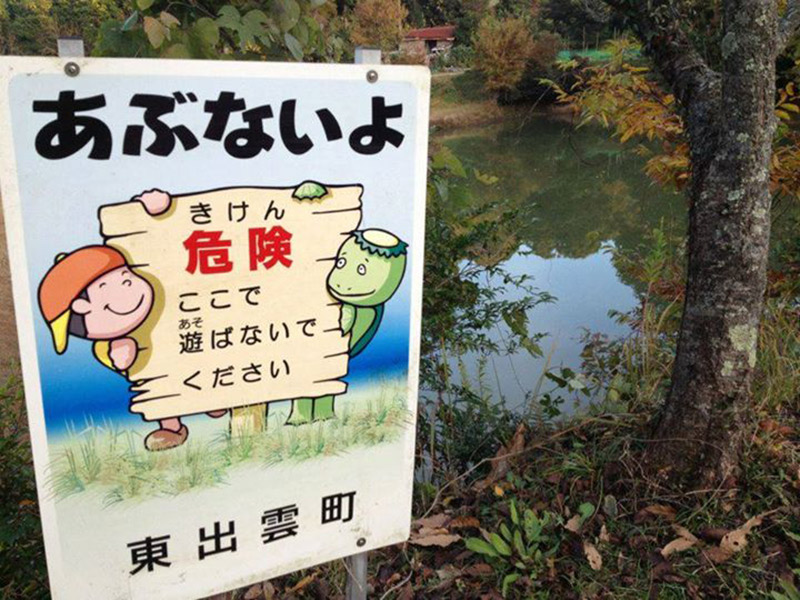
I think it's fair to say that the yokai Big Three are kitsune, tanuki and kappa. The first two are basically real animals, and their powers of mayhem are largely based on their shape-shifting abilities. Kitsune and tanuki can pretend to be something or someone else and cause supernatural trouble. Kappa, though, are an entirely different kettle of fish. They don't correspond precisely to any non-magical animal, and they don't have to pretend to be something else. They're dangerous just the way they are.
Kappa live in water and we don't. Thus gives them an advantage and a weapon, since we can't breathe the stuff. They're strong for their size, and can drag people into the water and hold them till they drown. In the old days they would even try to drown horses and cattle despite their difference in size (although they were often less successful than with humans). Children were warned about the kappa to keep them from swimming in dangerous places, and you'll still see kappa in signs like the one above. The skeptical might even think they were made up for this purpose. In some ways they seem to be an embodiment of the dangerous and dark aspects of water.
Kappa Kink

Kappa are not just strange and dangerous. They're kind of kinky. They don't want to drown you just for the hell of it. They go after people because they want your shirikodama 尻子玉. This is a ball that supposedly is found inside the human anus. (The origin of the shirikodama story is said to be from the open anuses of drowning victims. Although this loosening of the sphincter isn't exclusive to that manner of death.) The kappa supposedly reaches into your butthole with its hand to get this precious item or else – ick – sucks it out. And if that doesn't kill you, the drowning will.
What is this thing exactly? Some says it's the human soul. I have to say that if there is such a thing as a soul, that isn't where I'd choose to keep it. Another idea is that it's the Buddhist hojo, a sort of onion-shaped jewel that grants wishes (likewise on the storage location choice for that one). Yet another is that the ball is either actually the liver, or it's just in the way of getting at the liver, which the kappa is really after.
The kappa's obsession with our heinies also leads them to hide in toilets and try to stroke women's buttocks. But if that's all that happens, you're getting off easy: there are also tales of them raping women and leaving them pregnant with grotesque children. Most of these are killed at birth, although this tale from The Legends of Tono tells of someone who had a better idea just a bit too late:
A child looking something like a kappa was born into a certain family in Kamigo village. There was no definite proof that it was a kappa's, but it had bright red skin and a large mouth. It was indeed a disgusting child. Loathing the child and wanting to get rid of it, someone took it to a fork in the road and sat it down. After having walked only a short distance, he realized that he could make money by showing it. He went back, but it was already hiding and was nowhere to be seen.
Defense Against the Japanese Kappa

The kappa has a couple of weaknesses you can use against it: one, it loses its power if the water bowl on its head is dry, and two, it's very polite. So if you bow to it, it is compelled to bow back, and there's the trick. For instance, Japanese kappa like to challenge people to sumo matches, and are very strong on land, so it's bound to be a losing battle. But of course you have to bow before a sumo match, and there you go: the kappa has to bow back, and is rendered powerless when the water in its head dish spills out.
If you want to try to catch a kappa and kill it, your best bet is to use its worst desires against it. In the print above, the guy who's mooning the river is actually the bait: the idea is to lure the kappa in and catch it when it goes after the guy's shirikodama. If you've got a really brave and/or foolish friend who's willing to play that role, let us know how it goes.
A few more helpful facts are that kappas dislike gourds, sesame, ginger, and iron. In some places eating a cucumber and then swimming is said to attract kappas to attack, but in others, it's said to be protective. Check with the locals, I guess, before you try it.
Masters of Gasses
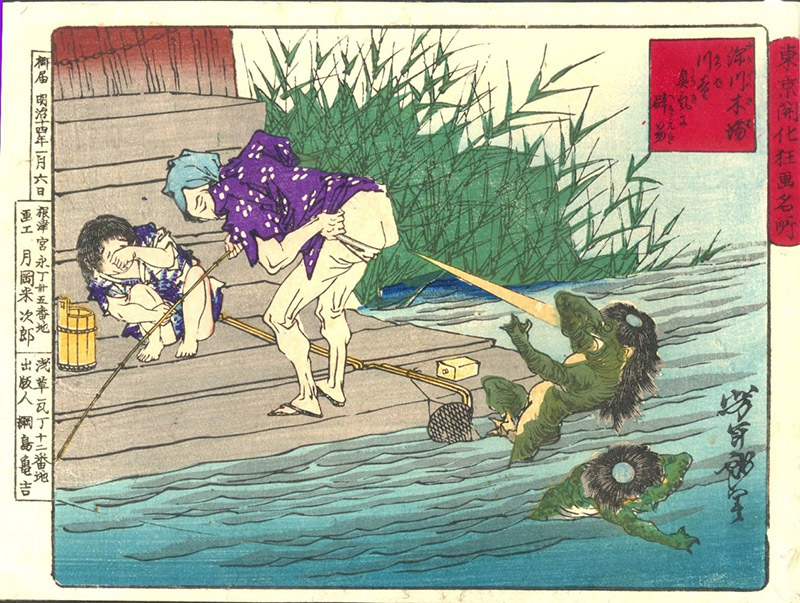
The jewel in our butthole is not the only buttocks-related aspect of the kappa legend. They're also renowned for something they do with their own behinds: farting. Experts that I consulted had no explanation for why kappa are supposedly so good at farting, so I can only assume it has something to do with their cucumber-heavy diet.
Despite their fondness for their own gas, they don't care for anyone else's (more or less how most of us feel, I guess.) You can see this from the print above, where it's clear that the kappa can toot it out but they can't take it.
Matt Alt explained to me that this print is an ad for a professional fart entertainer, sometimes called a fartiste (and we are not making this up, there was really such a thing). Apparently if you're in Japan and you want to convince people you have a talent for flatulence, this is the obvious comparison.
"I think the idea is that this guy's so good at what he does that he can even beat kappa at their own game," Alt says. "There's a famous saying in Japanese, "he no kappa" ("like a kappa farting") which is kind of used like our "piece of cake!" when someone does something easily."
You probably won't have such expert aim as a professional fartiste. But if you've got kappa trouble and all else fails: try farting at them.
Getting Along with Kappa
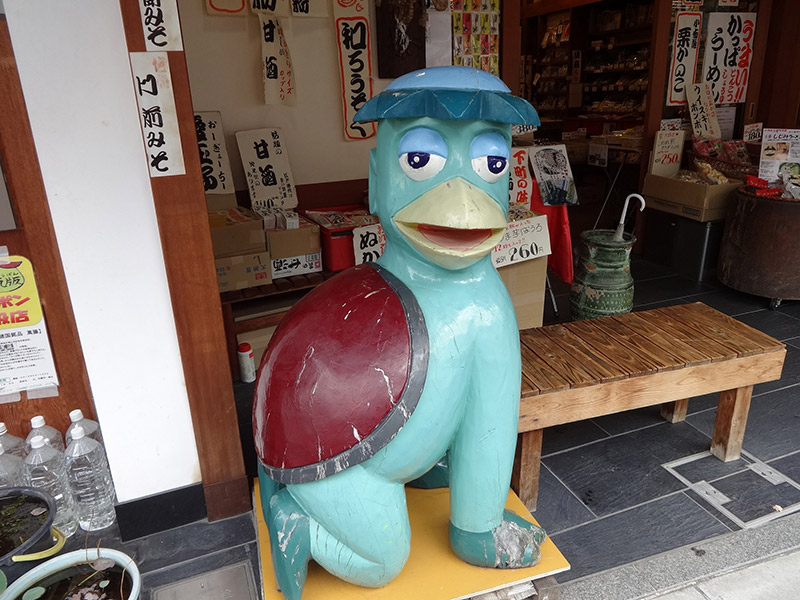
Kappa are said to be helpful to humans sometimes, although I suspect only when there's something in it for them. At least it's possible to make a deal with one in certain circumstances. One odd feature of the kappa is that it supposedly is talented in health care, making salves and medicines and setting broken bones. If you yank off a kappa's arm (like when it's sticking it up out of the toilet to fondle you) it knows how to reattach it, if it gets it back in time. They've been known to teach someone their medical secrets in return for getting their arm back.
There are shrines to Japanese kappa where you can leave cucumbers to appease them. Some are even devoted to kappa who have been helpful to people (probably because once they've been nice to us, we better stay on their good side). At Sogenji Temple in Asakusa, Tokyo, also known as Kappa-dera, the story is that the area was subject to repeated floods till a bunch of kappa helped build flood-control structures. So now they are venerated there. For you skeptics, Sogenji even has a relic to prove it: the mummified hand of an actual kappa. (Check out this video at about 19:25 to see Matt Alt visiting it.)
Talking Kappa
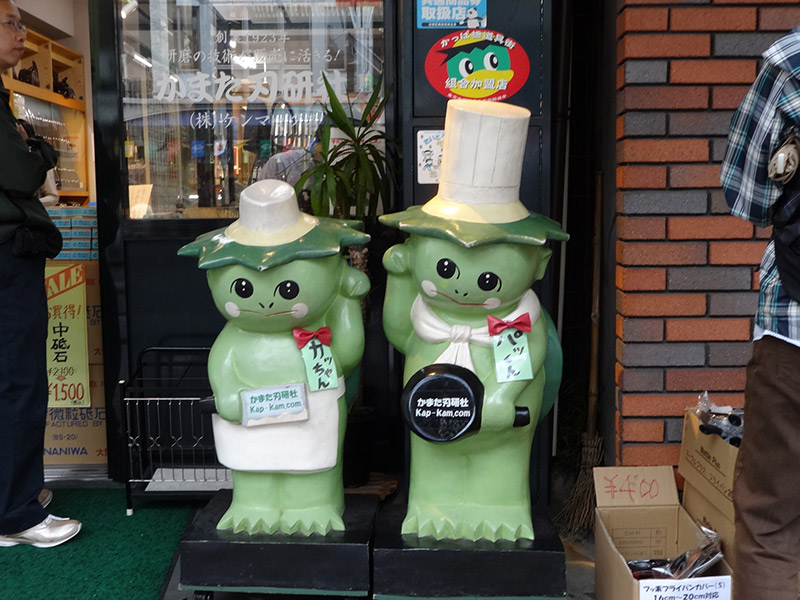
Along with "he no kappa," there are other sayings and proverbs that involve the kappa. "Kappa no kawanagare" means "even a kappa can drown," a warning that it's possible to screw up even the thing you know best. A kappa-hage is a man with bald spot on top of his head. Amagappa 雨合羽 means raincoat, referring to another weird feature of the kappa: they need to take off their skin to sleep. Without it, they are defenseless and can't go back into the water.
There's another story about kappa and raincoats that connects to another familiar reference to the kappa: the famous Kappabashi bridge in Tokyo. Apparently the first Kappabashi bridge was constructed by a raincoat merchant who hired kappa to labor on it. No word if they were the same kappa who built the floodworks honored by Sogenji Temple, but it's in the same place as that original bridge, so who knows?
The Modern Japanese Kappa
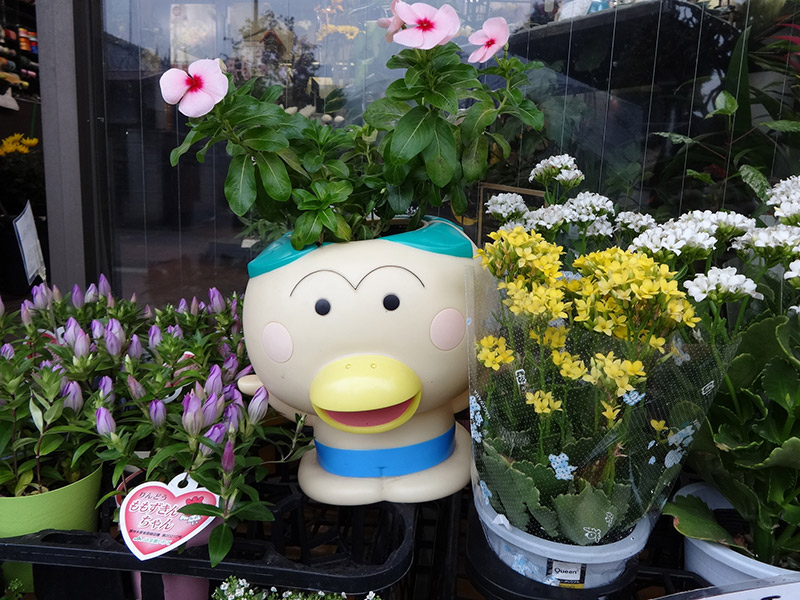
Like a lot of other yokai, such as the tanuki, kappa are often more cute than scary nowadays. Once a frightening "other," in the 20th century, stories about the kappa began to use them metaphorically, as stand-ins for humans. By the 1960s, Mizuki Shigeru drew the kappa in Sanpei the Kappa as perfectly adorable, with basically the same face as his (mostly) human friend, and wrote stories where they are mistaken for one another.
Kappa are now used in advertising and as logos in a way that wouldn't make sense if people still mainly pictured them as a fearsome anus-attacking drowner of humans and livestock. There are cute character goods and local specialties like these buns:

Ironically, now they can even be used to invite you into the onsen, which would have been the worst possible idea in the old days:

In the 1970s, rural revitalization projects and festivals started using the kawaii-ized kappa as a symbol, playing on its association with nature and the disappearing country lifestyle. While it's still used in signs to warn against swimming, some look more like friendly advice than a threat. They're also used in posters asking people not to litter and in campaigns to protect the environment, including clean water.
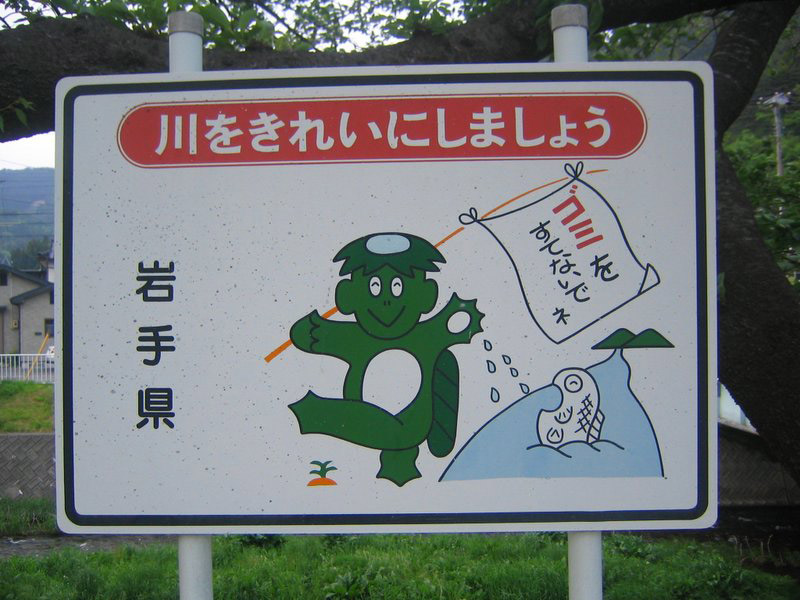
Nowadays, it seems like there's a sense in which the Japanese kappa is as much at risk from us as vice versa: once a personification of the dangers of nature, now it's often used as a symbol of the natural world we need to protect. As Michael Dylan Foster puts it, "A yokai that used to represent the violence and unpredictability of the natural world, and especially water, has now literally become a poster child for the effort to stop the sacrifice of nature."
Like that quote implies though, nature has a lot to be mad at us for… so if you do run into a kappa, it's still best to take care, because it might be angry.
